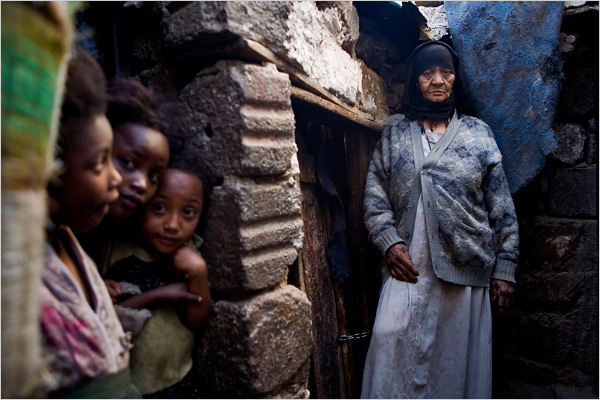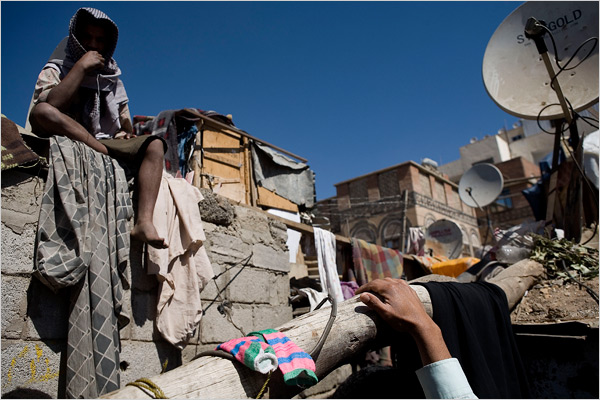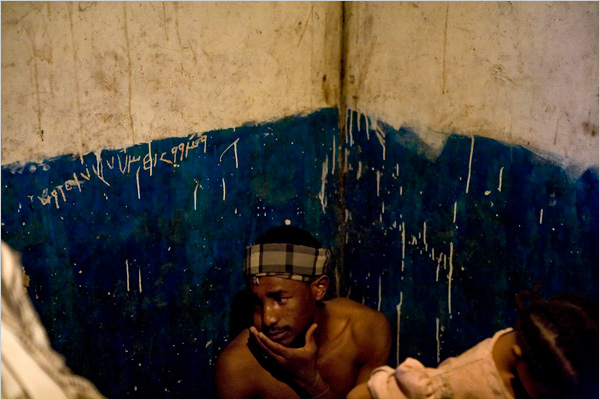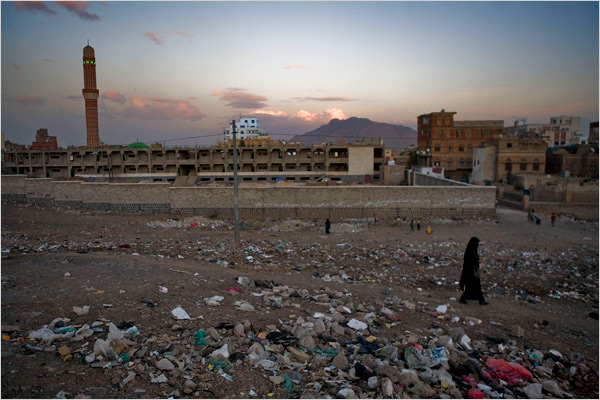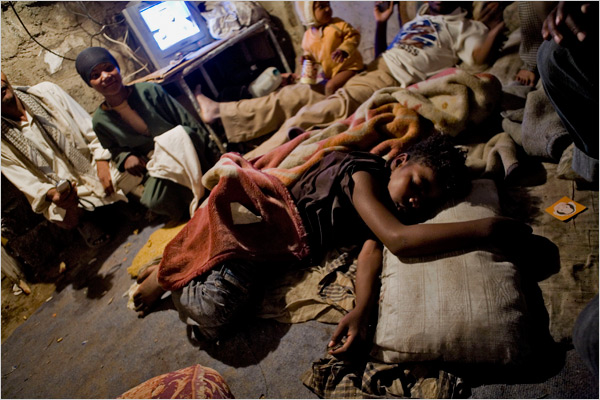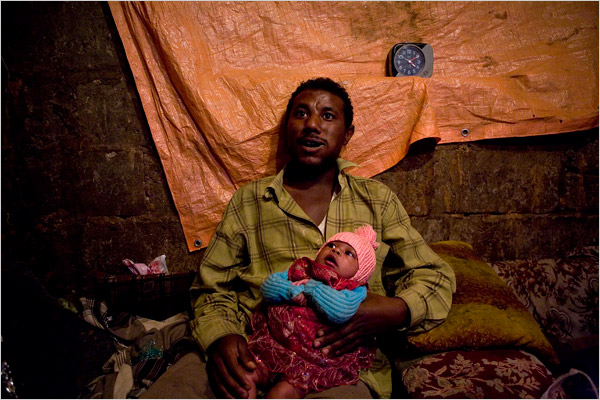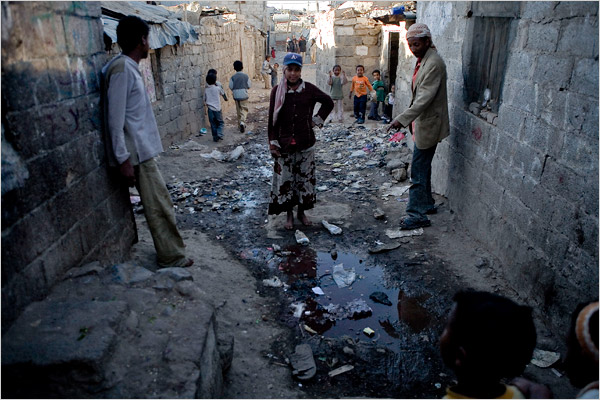|
Yemen's Al Akhdam |
|
They are known as “Al Akhdam” — the servants. Set apart by their African features, they form a kind of hereditary caste at the very bottom of Yemen’s social ladder.
Y E M E N ' S M A R G I N A L I Z E D C L A S S
FEBRUARY 27, 2008
Degrading myths pursue the Akhdam, and they are reviled as outsiders in their own country, descendants of an Ethiopian army that is said to have crossed the Red Sea to oppress Yemen before the arrival of Islam.
As a result, the Akhdam have languished at the margins of society, suffering a persistent discrimination that flouts the egalitarian maxims of the Yemeni state.
Some Akhdam have found ways to improve their station on their own. But for many others, there is little hope for doing anything except sweeping the streets.
Yemen’s Marginalized Class By Robert F. Worth The New York Times February 27, 2008
SANA, Yemen — By day, they sweep the streets of the Old City, ragged, dark-skinned men in orange jump suits. By night, they retreat to fetid slums on the edge of town.
They are known as “Al Akhdam” — the servants. Set apart by their African features, they form a kind of hereditary caste at the very bottom of Yemen’s social ladder.
Degrading myths pursue them: they eat their own dead, and their women are all prostitutes. Worst of all, they are reviled as outsiders in their own country, descendants of an Ethiopian army that is said to have crossed the Red Sea to oppress Yemen before the arrival of Islam.
“We are ready to work, but people say we are good for nothing but servants; they will not accept us,” said Ali Izzil Muhammad Obaid, a 20-year-old man who lives in a filthy Akhdam shantytown on the edge of this capital. “So we have no hope.”
In fact, the Akhdam — who prefer to be known as “Al Muhamasheen,” or the marginalized ones — may have been in this southern corner of the Arabian Peninsula for as long as anyone, and their ethnic origins are unclear. Their debased status is a remnant of Yemen’s old social hierarchy, which collapsed after the 1962 revolution struck down the thousand-year-old Imamate.
But where Yemen’s other hereditary social classes, the Sayyids and the judges and the sheiks, and even the lower orders like butchers and ironworkers, slowly dissolved, the Akhdam retained their separate position. There are more than a million of them among Yemen’s fast-growing population of 22 million, concentrated in segregated slums in the major cities.
“All the doors are closed to us except sweeping streets and begging,” Mr. Obaid said. “We are surviving, but we are not living.”
The Akhdam have not been offered the kind of affirmative action programs India’s government has used to improve the lot of the Dalits, or untouchables, there. In part, that is because Yemen never had a formal caste system like India’s.
As a result, the Akhdam have languished at the margins of society, suffering a persistent discrimination that flouts the egalitarian maxims of the Yemeni state.
Even the recent waves of immigrants from Ethiopia and Somalia, many of them desperately poor, have fared better than the Akhdam, and do not share their stigma.
The Akhdam who work as street sweepers, for instance, are rarely granted contracts even after decades of work, despite the fact that all Yemeni civil servants are supposed to be granted contracts after six months, said Suha Bashren, a relief official with Oxfam here. They receive no benefits, and almost no time off.
“If any supervisor wants to dismiss them, they can do that,” said Ali Abdullah Saeed Hawdal, who started working as a street sweeper in 1968. “The supervisors use violence against them with no fear of penalties. They treat them as people with no rights.”
The living conditions of the Akhdam are appalling, even by the standards of Yemen, one of the poorest countries in the Arab world.
In one Akhdam shantytown on the edge of Sana, more than 7,000 people live crammed into a stinking warren of low concrete blocks next to a mountain of trash. Young children, many of them barefoot, run through narrow, muddy lanes full of human waste and garbage.
A young woman named Nouria Abdullah stood outside the tiny cubicle — perhaps 6 feet by 8 feet, with a ceiling too low to allow her to stand up — where she lives with her husband and six children. Inside, a thin plastic sheet covered a dirt floor. A small plastic mirror hung on the wall, and a single filthy pillow lay in the corner.
Nearby, a single latrine, in a room approximately 3 feet by 3 feet, serves about 50 people. The residents must carry water in plastic jugs from a tank on the edge of the slum, supplied by a charity group.
Wearing a brown dress, with a rag tied around her head, Ms. Abdullah said she and her family brought in no more than 1,000 Yemeni riyals a week, about $5. She begs for change, while her husband, Muhammad, gathers metal and electrical components from trash heaps and sells them.
Like most people in the shantytown, they have no documents, and they do not know how old they are.
“We are living like animals,” Ms. Abdullah said. “We cook and sleep and live in the same room. We need other shelters.”
When the winter rains come, the houses are flooded, she said. On the cold days in winter, the family burns trash to stay warm.
Richard Bramble, a British doctor who works in a charity-sponsored clinic inside the shantytown, said half of the deaths there over the past year were of children under the age of 5, and one-quarter were in the first month of life.
The death rates from preventable disease are even worse than the nationwide average in Yemen, where overall infant mortality is already an appalling one in nine, and maternal mortality is one in 10. Most of the women among the Akhdam start having children in their early teens, residents said.
Part of the problem, many members of the community say, is that most of the Akhdam have internalized their low status and do not try to better themselves, find real jobs or seek an education. Much of their meager income goes to buying qat, the plant whose leaves many Yemenis chew for its mildly narcotic effects.
“They do not even push their children to become soldiers,” said Muhammad Abdu Ali, the director of the medical clinic in the shantytown and one of the Akhdam. “They have given up on changing their situation.”
In the past two years, members of the Akhdam have begun to organize, creating a political front to lobby the government and seek development aid from charity groups. Earlier this month, hundreds of Akhdam demonstrated in the city of Taiz to protest their mistreatment, and afterward a government supervisor accused of stealing money from Akhdam street sweepers was fired.
But efforts to help the Akhdam have sometimes backfired. International donors have mostly preferred to work through Yemeni mediators, who have often misused or stolen the money intended for the Akhdam, said Rashad al-Khader, a Yemeni lawyer who has been representing the Akhdam for seven years.
The Yemeni government has occasionally built shelters for the Akhdam, but has not provided them documents for those shelters or the land, Mr. Khader said. And it has done little to help them improve their access to health care and education, despite a series of election-year promises to the community, according to Akhdam leaders.
The government does, however, seem embarrassed by the plight of the Akhdam, Mr. Khader said. When the new national political front was formed a few months ago, government officials insisted that its proposed name be changed — removing the term “the marginalized ones” in favor of “those in extreme poverty.”
The popular notion that the Akhdam are descendants of Ethiopian oppressors appears to be a myth, said Hamud al-Awdi, a professor of sociology at Sana University. Most of them have roots in villages in Red Sea coastal plain of Yemen, and many of them may have African origins, he added. Little else about them is clear, despite a number of academic studies.
Some Akhdam have found ways to improve their station. Mr. Hawdal, after working as a street sweeper for 20 years, became a supervisor, and now lives in central Sana with his wife and five children in two rooms that are relatively clean, a world away from the slums at the city’s edge.
As he leaned on a cushion chewing qat, with a television chattering in the background, Mr. Hawdal pointed proudly to a plaque on the wall commemorating his long service as a sweeper. He has sent all of his children to school, unlike most of the Akhdam, and one of them made it as far as ninth grade.
But Mr. Hawdal acknowledged sadly that all of his children had since dropped out. He was running out of money, he said. But that was not the only reason.
“They had no hope of doing anything except street sweeping,” he said.
Yemeni caste trapped in a dark age; Akhdam face discrimination, are restricted to shantytowns Peter Willems and Myrna Amine The Washington Times December 01, 2004
SAN'A, Yemen
"If we could lighten our black skin, we would be able to get jobs and support ourselves," said Saleh Ali, 20. "We can't do anything other than take the broom and clean the streets." Mr. Ali is a member of the large Yemeni underclass known as Akhdam.
The Akhdam, literally "servants" in Arabic, is the lowest rung in the Yemeni caste system and by far the poorest. Marginalized and shunned by mainstream society, its members live in small shantytowns, mostly in big cities, including the capital, San'a.
In the shantytown near Bab Al-Yemen - the famous gate to Old San'a - families, often with more than a dozen members, live in one- room dwellings. Some are made of stones, but most have been thrown together using aluminum, cardboard or other waste material.
Although government projects have contributed electricity and better access to water, the communities still lack toilet facilities and a sewage system. Children here run barefoot on unpaved roads littered with human waste and garbage.
Fatima Hussein lives with her husband and nine children in a 7- by-7-foot shack in one of the capital's 11 shantytowns. Holding a baby to her breast, she said: "My husband can't find work, so I have to go out to beg."
The men typically are hired by the city government as street cleaners or garbage collectors. The average monthly salary for a sanitation worker, around $50, is not enough to support a family, and the jobs are not secure, so women and children have to work or beg.
"I work as a street cleaner, but I'm not always needed," said Adel Hussein al-Amri, a father of five. "There are no guarantees from the government for us to work."
With the need for income, many children are unable to go to school because they are sent out to work. Those who try to get an education often drop out because of harassment. They frequently are mocked as "black," "Akhdam" and "dirty," and sometimes are made to sit in the back of the classroom. A World Bank study showed that 45 percent of children younger than 16 were enrolled in school in 1999, and another survey found the national literacy rate was 43 percent.
"The kids are beaten up in school because they are from our communities," said Ismail Hassan, 22, married and a father of two. "The fact is that even if we study, we end up cleaning streets because that's what society expects us to do."
Society's expectations stem from more than racial differences. The Akhdam were condemned to collect human waste before the advent of sewerage systems.
The common belief is that the Akhdam descended from the remnants of the Ethiopian kingdom in Yemen, defeated in the sixth century. Its soldiers were consigned to the lowest form of servitude. As a result, they are viewed as dirty and polluted. As one popular Yemeni proverb puts it: "Clean your plate if touched by a dog, but break it if touched by a Khadem" - the singular form of Akhdam.
"Once I joked with my brother that I had eaten with a Khadem," recalls a student at San'a University. "He became angry and said: 'Stay away from me! You're a Khadem. They're filthy, and they don't pray!' "
In Yemen's conservative Muslim society, Yemenis see the Akhdam as not fulfilling their religious duties, and therefore consider them impure. Huda Seif, a fellow at Emory Law School, said in a report last year: "The further condemnation of the 'non-Arab' as a fallen Muslim, who is unable to fully carry out the moral codes of Islam, only serves to legitimize the initial ethnic difference and prejudices, which are unequivocally proscribed in Islamic teachings."
No official figures exist on the Akhdam population, but a study conducted by the United Nations Children's Fund in the late 1990s estimated there were roughly 200,000 in Yemen.
Despite the social pressure, there were a few cases of Akhdam who moved out of shantytowns into neighborhoods and tried to integrate themselves into Yemeni society.
However, many of them moved back to the shantytowns "because they were harassed and excluded," said Afrah al-Ahmadi, head of the health and social protection unit of the Social Fund for Development. "They couldn't handle it."
Some people believe the communities need to work from within on self-development and solving some of their problems. The Akhdam marry young, sometimes have more than one wife, and have large families.
They spend part of their income on qat, a plant stimulant widely chewed in Yemen.
"But there is an internal factor," said Mr. al-Ahmadi. "They have very low self-esteem. They believe strongly that they cannot change."
Although most international organizations in Yemen have overlooked the needs of shanty communities, the Community Empowerment Project of CARE International has the goal of changing their self-perceptions by helping them develop their own projects.
Some of these involve skill training, adult-literacy programs, and water distribution businesses. Three communities, for instance, were provided with water trucks and sell water to residents at an affordable price.
Eliminating social prejudices against the Akhdam and improving their living conditions will take time. "So much more needs to be done," said Adam Taylor-Awny, program technical adviser at CARE International in San'a.
"This includes living conditions, sanitation, integration into society, education and health." But some do not have much hope.
"It does not matter what we do. Nothing is going to change," said Mr. Ali. "I wish I were like everyone else."
© 2004 Washington Times. All rights reserved.
Caste: One in every 25 people suffers from caste discrimination based on the kind of work they do and their family origins. That is around 250-300 million people globally and 179 million in India alone. Many countries have laws against discrimination, some specifically against caste discrimination, but they are rarely enforced.
New Internationalist July 01, 2005
Common features of caste systems [1]
* Physical segregation--for example, not being allowed to drink from the same cup or share the same water source as higher castes.
* Social segregation, including a prohibition on intercaste marriages.
* Work in traditional occupations often associated with death or filth.
* Debt bondage due to poor wages for lower-caste occupations. An estimated 25-60 million people in India are bonded labourers, working in slave-like conditions in order to pay off a debt. The majority are Dalits.
* High levels of illiteracy, poverty and landlessness.
* Perpetrators of crimes against lower caste communities rarely punished even where legislation exists to do so.
* Prejudice, based on notions of purity and pollution.
* Women face triple discrimination on the basis of sex, class and caste. Under the devdasi system, thousands of Dalit girls in India's southern states are dedicated to a deity or to a temple. They are unable to marry, forced to become prostitutes for upper-caste men, and eventually auctioned into brothels.
Caste around the world [4]
Senegal
Name of community: Neenos, comprising 10-20% of Wolof society, are the people of caste. In Mande-speaking areas, the Nyamakalaw comprise about 5% of the population. Also, the Jonow (slaves and their descendants).
Numbers: Approximately 15% of the total population.
Traditional occupations: Neeno--blacksmiths, leatherworkers, midwives, circumcision performers. Nyamakalaw--blacksmiths, bards and leatherworkers.
Legislation: Constitutional guarantee of freedom from discrimination.
Burkina Faso (also in Mali, Niger, Algeria and Libya)
Name of community: Bellah, the slave caste of the Tuareg community.
Traditional occupations: Slaves to higher caste 'owners', usually as unpaid labourers, producing tradeable goods such as salt for their owners.
Legislation: The Constitution prohibits caste discrimination.
Nigeria (also northern Cameroon and the Chad basin of central Africa)
Name of community: Osu, Oru, Adu-Ebo, Oruma, Ume, Ohu, Omoni. Also blacksmith and potter castes in Mandara Hills region.
Numbers: 2-4 million.
Traditional occupations: Osus are assistants to high priests of the traditional religion. Outcastes in the Mandara Hills region are blacksmiths, potters, leatherworkers, weavers, undertakers, midwives and drummers.
Legislation: Law prohibiting Osu caste system exists in Anamba and Enugu states.
Mauritania
Name of community: Haratin.
Numbers: 90,000-300,000.
Traditional occupations: The Haratin ('black moors') are slaves and ex-slaves of the Bidan ('white moors').
Legislation: Slavery formally abolished in 1980.
Ethiopia
Notions of purity and pollution are prevalent in southwestern Ethiopia, though the impurity can be temporary.
Traditional occupations: Tanners, potters, blacksmiths, weavers.
Legislation: None.
Yemen [5]
Name of community: Akhdam (literally 'servants').
Numbers: The largest and poorest minority, estimated at around 200,000.
Traditional occupations: Street cleaning, porters, foot-soldiers and shoemakers. Women and children beg. Over half are unemployed.
Legislation: Unclear.
Rwanda (also Burundi, Democratic Republic of Congo and Uganda) Name of community: Twa.
Numbers: 1-2% of the population. Little or no representation in positions of authority or power.
Traditional occupations: Hunter-gatherers, potters, jesters.
Legislation: None.
Kenya
Name of community: Watta; also among Indian Diaspora.
Numbers: 2,000-3,000 Watta.
Traditional occupations: Hunter-gatherers (Watta).
Legislation: Yes.
Niger [6]
Name of communities: Touaregs, Hausa, Djerma-Songhai, Peuls, Kanouri, Gourmantchema, Boudouma, Issawaghans.
Numbers: The Hausa make up 54% of the population, the Djerma-Songhai 22%, the Touaregs 12%. Each has its own caste system.
Traditional occupation: Barbers, butchers, blacksmiths, potters, griots, shoemakers, weavers, well-diggers and slaves.
Legislation: Since 1999.
Somalia
Name of community: Sab ('low caste') including Midgan (Mahdibhan), Tumal, Yibir.
Numbers: Approx 1% of the population.
Traditional occupations: Usually 'clients' (slaves) to larger Somali 'noble' clans. Tumal--blacksmiths; Yibir, Midigan--hunters and leatherworkers.
Legislation: None.
Crime against Dalits in India
Crime against Dalits in India still goes unpunished, despite many laws against it. The number of cases of atrocities against Dalits rose from 7,445 in 1998 to 33,507 in 2002. Few of these end in convictions. [2]
every hour ...
... two Dalits are assaulted.
every day ...
... three Dalit women are raped.
... two Dalits are murdered.
... two Dalit houses are burned. [3]
Pakistan
Name of community: Dalit.
Numbers: Approximately 2 million. Sunni Muslims of the Swat region in northern Pakistan have a system of social stratification. In Sindh province there are around 1.8 million people living in bondage as agricultural labourers or in the brick kilns, the majority of whom are Dalits from India. There are also Dalits in Punjab province.
Traditional occupations: Sweepers, washerpeople, barbers, those who work with the innards of animals.
Legislation: None.
[ILLUSTRATION OMITTED]
Sri Lanka
Name of community: Rodi or Rodiya (Sinhalese); Pallars, Nalavas and Paraiyars (Tamil).
Numbers: Unknown. Both caste systems have their origin in India, but the Sinhalese caste system is not linked to the Hindu codification, but rather to feudal divisions of society.
Traditional occupations: The Tamil caste system is occupation-based as well as hereditary. Pallars and Nalavas (descendants of former slaves) work on dominant castes' lands; Paraiyars are engaged in so-called unclean occupations.
Legislation: The Constitution prohibits discrimination on the basis of caste.
Nepal
Name of community: Dalit (about 25 sub-castes).
Numbers: Approx. 4.5 million, 21% of total population.
Traditional occupations: Removers of dead carcasses, scavengers, artisans and singers.
Legislation: Caste discrimination constitutionally a punishable offence.
Bangladesh
Name of community: Methor.
Traditional occupations: Sweepers, cleaners of toilets, drains and other dirty places.
Legislation: None.
Japan
Name of community: Buraku (traditionally eta and hinin).
Numbers: Approximately 3 million, 2.5% of total population.
Traditional occupations: The eta--disposers of dead cattle, producers of leather, security guards and sweepers. The hinin--security guards, executioners and performers.
Legislation: Yes.
India
Name of community: Dalit or Scheduled Castes (numerous sub-castes, such as the Chamars, Arunthathiyurs, Pallars, Bhangis, Malas, Madigas, etc), formerly known as Untouchables.
Numbers: 179 million (2001 Census), 20% of total population.
Traditional occupations: Leather workers, cobblers, scavengers, sweepers, cremation workers, drummers, removers of animal carcasses, landless agricultural labourers.
Legislation: Yes, since 1948.
The South Asian Diaspora
Caste discrimination has been exported from South Asia by those who have settled elswhere.
There have been no statistical surveys of the numbers of Dalits living in other countries, but anecdotal evidence indicates that people from the same caste in a foreign land tend to stick together and to keep their practices and their prejudices intact.
Reference:
[1] National Campaign for Dalit Human Rights www.dalits.org
[2] Human Rights and Law Unit of Indian Social Institute, New Delhi
[3] www.imadr.org/project/dalit/atrocity.html
[4] National Campaign for Dalit Human Rights: www.dalits.org/globalcastesystems.htm
[5] www.yobserver.com/cgi-bin/yobserver/exec/view.cgi/1/4266
[6] www.idsn.org/pdf/Africa/Niger.pdf
COPYRIGHT 2005 New Internationalist Magazine
Their debased status is a remnant of Yemen’s old social hierarchy, which collapsed after the 1962 revolution struck down the thousand-year-old Imamate.
The Akhdam have not been offered the kind of affirmative action programs India’s government has used to improve the lot of the Dalits, or untouchables, there. In part, that is because Yemen never had a formal caste system like India’s.
The living conditions of the Akhdam are appalling, even by the standards of Yemen, one of the poorest countries in the Arab world.
|
